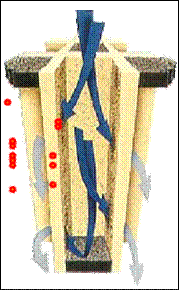


|
Problem Description |
|
Cummins Inc. produces their diesel filters through their Fleetguard/Nelson business division. Fleetguard/Nelson business is a leading designer and manufacturer of filters, filtration and exhaust systems for on- and off-highway applications ranging from diesel-powered equipment to small, gasoline engine applications. The specific type of filter we are targeting is known as the Fleetguard Emissions Solution diesel particulate filter. These filters are made of dense cordierite. They typically have a cell density of 300 cells per square inch with 8 mil thick walls. Alternating cells are plugged at each end of the filter, forcing the exhaust gas to pass through the cell walls. Soot that enters the filter at high velocity, from engine speeds, tends to be concentrated in the rear of the filter inlet channels. This high speed soot also exhibits higher density than the soot accumulated at idle speeds, which tends to collect on the front of the filter. The collected soot is eventually oxidized in the filter and turned to ash. The soot oxidation process can be well controlled when the amount of soot is limited, but if it exceeds specified limits, the thermal gradients will damage the filter. A soot oxidation schedule which is too frequent results in loss of fuel economy, as often the oxidation of soot requires additional fuel.
In order to circumvent this problem and provide a possible solution, the overall goal of the Cummins 1 Senior Design Team is to develop a filter sensor that will enable the operator to directly determine how much soot and other particulates are present in the filter at any given time. This can be accomplished by any reasonable means, with methods including measuring the soot flowing into the filter or measuring the amount of soot in the filter. As delineated in prior teleconferences that we had with our Cummins contact (Roger England), the following are specifications for the soot filter sensor. The needs are ranked in order of importance and criticality, with 1 being the most critical requirement.
1. Accuracy of + ½ gram per liter 2. Diameter ranging in size from 9 inches to 13 inches 3. Fairly reproducible (in the range of 200,000 units per year) 4. Capable of directly measuring the amount of soot in the filter 5. Able to take measurements while vehicle is in operation 6. Able to fit and operate on the vertical stack of a semi-truck 7. Cost effective 8. Durable 9. Able to withstand high temperatures |


|
Cummins |
|
Diesel Particulate Filter |